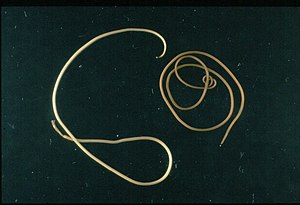worms
A whole series of groups ( taxa ) of invertebrates, some of which are only very distantly related, are called worms (singular worm ) . They are characterized by an elongated, tubular body. Originally of the Zoology all worm-like animals, due to their physical characteristics in the class of the worms (Vermes) together (for example by Linnaeus used). In the Middle Ages, on the other hand, "all animals that have no feet or crawl around the earth" were called worms. Because the many different worm-shaped animal species are only distantly related to each other and have completely different anatomy and morphology , this idea had to be abandoned. The comparison of "higher worms" (Annelida) and "lower worms" (ashelminths and plathelminthes) is now outdated. Nevertheless, the summary “worms” is also used in some scientific contexts, for example in medicine for worm diseases or in biology when describing the prey spectrum of other animals.
features
A worm is an animal with an elongated, rounded or flattened body structure, which often appears to be radially symmetrical on the outside , even if the animal is actually bilaterally symmetrical - all worms belong to the Bilateria . The lack of extremities such as legs or antennae and the resulting crawling mode of locomotion are also typical. Most worms also lack a solid internal or external skeleton ( exoskeleton ); the animals are often supported by a hydroskeleton , i.e. a system of fluid-filled chambers inside the body.
Outside of the technical jargon, the term worm is also used for some insect larvae, for example for the larva of the oil beetle or the mealworm , which, however, is due to several characteristics, e.g. B. the presence of legs and antennae as well as a chitin armor , can be clearly identified as an insect and therefore does not represent a worm in the technical sense.
In the Middle Ages many other "crawling animals" were often called worms (see Lindwurm ). Diseases were sometimes assigned to a supposed “worm”, such as the “circulating worm” or “fingerworm” in the case of panaritium or the “ toothworm ” in the case of toothache.
Systematics
The term “worm” is only used in zoology for invertebrates , even if some vertebrates, such as blind snakes and double creeps, are externally reminiscent of worms. Except for the acorn worms , they are among the primordial mouths (protostomia). The fact that it is not possible to make a further general classification for all types of worms shows what a heterogeneous group the worms represent. It contains both lophotrochozoa and molting animals (Ecdysozoa). The different animal phyla that have worms include:
- Roundworms (Nematoda)
- Horseshoe worms (Phoronida)
- Hedgehog worms (Echiura)
- Cupworms (Entoprocta)
- Jaw mouth (Gnathostomulida)
- Gillfish (Hemichordata)
- Scratchworms (Acanthocephala)
- Arrow worms (Chaetognatha)
- Flatworms (Plathelminthes)
- Priapulida (Priapulida)
- Annelids (Annelida)
- String worms (Nematomorpha)
- Squirtworms (Sipunculida)
- String worms (Nemertini)
The earthworms belong to the group of annelids .
In the trunk of the arthropods, which also include insects , arachnids and crustaceans , tongue worms (pentastomida), which belong to the crustaceans (Crustacea), are found as worm-like representatives.
Scientists who deal with one or more of the animal phyla mentioned above are still called helminthologists (translated as "wormologists").
meaning
Some parasitic worms known as helminths designated tapeworms , roundworms and flukes , can in humans or in other animals worm diseases cause, but there are also many for humans harmless worms or even those that useful are (eg. As the earthworm which improves the quality of the soil he inhabits). Because of the heterogeneous origin of the various worms, the habitats and habitats are of course just as different. Worms are not only found on land (such as the earthworm mentioned above), but also marine , such as the beard worms , which can survive in large numbers even in extreme locations in the deep sea . Worms are often of great importance in ecosystems as destructors (breakdown of organic matter), but are also often food for carnivorous animals such as B. Birds , small mammals or fish .
See also
literature
- Karl Enigk: History of helminthology in the German-speaking area. Stuttgart and New York 1986.
Individual evidence
- ^ Max Höfler: German book of names of diseases. Piloty & Loehle, Munich 1899 (Reprographic reprint: Olms, Hildesheim and New York 1970 and 1979, ISBN 1-174-35859-9 ), p. 820.

